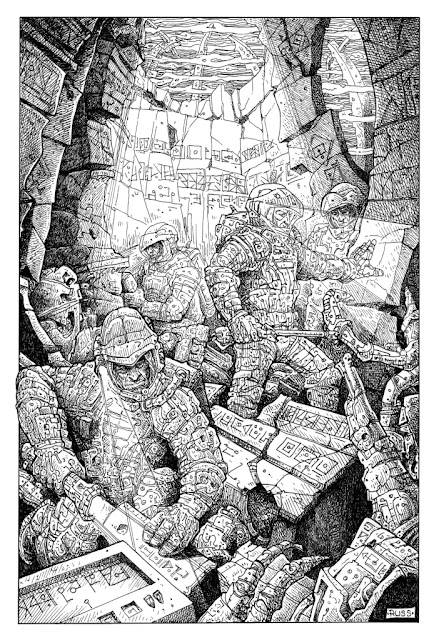 I find it a great irony that, while Chaosium's Call of Cthulhu has undoubtedly played an outsized role in the increased visibility and recognition of the works of H.P. Lovecraft in popular culture, the game itself owes more to August Derleth's idiosyncratic interpretation of HPL's Mythos than it does to the views of the Old Gent himself. This is no criticism, just a statement of facts as I look back on more than four decades' worth of Call of Cthulhu adventures and campaigns, starting with Shadows of Yog-Sothoth in 1982. Except for a handful of exceptions, Chaosium's vision differs only in details from that of Derleth's lurid, melodramatic The Trail of Cthulhuhe Trail of Cthulhu, in which scholar-adventurer Laban Shrewsbury battles the forces of the Mythos (and its human toadies) across time and space.
I find it a great irony that, while Chaosium's Call of Cthulhu has undoubtedly played an outsized role in the increased visibility and recognition of the works of H.P. Lovecraft in popular culture, the game itself owes more to August Derleth's idiosyncratic interpretation of HPL's Mythos than it does to the views of the Old Gent himself. This is no criticism, just a statement of facts as I look back on more than four decades' worth of Call of Cthulhu adventures and campaigns, starting with Shadows of Yog-Sothoth in 1982. Except for a handful of exceptions, Chaosium's vision differs only in details from that of Derleth's lurid, melodramatic The Trail of Cthulhuhe Trail of Cthulhu, in which scholar-adventurer Laban Shrewsbury battles the forces of the Mythos (and its human toadies) across time and space.
I was reminded of this recently when I re-read Keith Herber's eight-chapter campaign, The Fungi from Yuggoth. First published in 1984, the book carries the subtitle "Desperate Adventures Against the Brotherhood." This is both a reference to its primary antagonists, the Brotherhood of the Beast, and a signal that, like Shadows of Yog-Sothoth before it, The Fungi from Yuggoth is more of a Mythos-tinged Republic serial than a subtle evocation of Lovecraft's cosmicism. I reiterate: this is no criticism. However, I feel it's important to deflate the all-too-common pretension that Call of Cthulhu has ever been a particularly faithful adaptation of the worldview of Lovecraft's tales to the roleplaying medium, as products like this one make clear.
The premise of the campaign is that, in the 18th century B.C., an Egyptian priest called Nophru-Ka – not to be confused with the dark pharaoh Nephren-Ka, who is apparently a different person altogether – uttered a cryptic prophecy that was eventually preserved in the Necronomicon. As interpreted by the madmen who founded the secret society known as the Brotherhood of the Beast, the prophecy spoke of a time when a descendant of Nophru-Ka, who would usher in a new world ruled by the beings of the Mythos. At the start of the campaign (mid-1928), the Brotherhood long ago found Nophru-Ka's descendant, Edward Chandler, whom they have been grooming for his prophesied role since he was a child. Naturally, it's up to the Investigators to prevent this.
In typical Call of Cthulhu – and cliffhanger serial – fashion, preventing the ascendancy of Edward Chandler requires the Investigators to travel across the globe, searching for clues, artifacts, and allies to aid them in their efforts. Over the course of the campaign's eight chapters, the Investigators travel from New York to places as different as Boston, Transylvania(!), Egypt, Peru, and San Francisco, with an optional stopover at the Great Library of Celaeno in the Hyades Cluster, some 150 light years away from Earth (a site invented by August Derleth in the aforementioned The Trail of Cthulhu). Along the way, they tangle with an equally diverse group of foes: gangsters, cultists, mummies, Deep One hybrids, the titular Fungi, and more. There's plenty going on in this campaign and I have no doubt whatsoever that it would be a lot of fun to play.
At the same time, The Fungi from Yuggoth, with its global conspiracy to shepherd the rise of a Mythos Antichrist, doesn't feel much like Lovecraft. There are plenty of plot elements derived from Lovecraft in its eight chapters, but they're strung together in a way that feels like more an Indiana Jones movie than something coming from the pen of HPL. As I re-read the book, I could practically hear the John Williams soundtrack and see an animated red line traveling across a globe, marking each city or location the Investigators visited in their "desperate adventures against the Brotherhood." All that's missing are the Nazis, though, since the campaign takes place in the late 1920s, that's understandable (though one of the main cultists is German).
The Fungi from Yuggoth is weapons grade Derlethium – and that's fine. As I stated at the beginning of this post, nearly every Call of Cthulhu adventure ever published, including the deservedly praised Masks of Nyarlathotep, is, at base, a pastiche of Derleth's pastiches of Lovecraft. Many of these products, including The Fungi from Yuggoth, are very well done. As roleplaying game scenarios, they're some of the best things the hobby has ever produced and I do not hesitate to recommend them. I have enjoyed Call of Cthulhu since its original release in 1981 and hope to one day get the chance to enjoy it again.
In all those years, however, I don't believe I've ever played an adventure or a campaign that offered more than the occasional genuinely Lovecraftian moment. The rest of my experiences were of pulp adventure with a Mythos twist. That's probably for the best. I'm not sure that an "authentic" experience of Lovecraft's nihilistic cosmicism would be a lot of fun to play out at the table. Ultimately, that's probably why nearly everything Chaosium has ever published for Call of Cthulhu unintentionally looks to Derleth for its inspiration: it's just more fun.


























